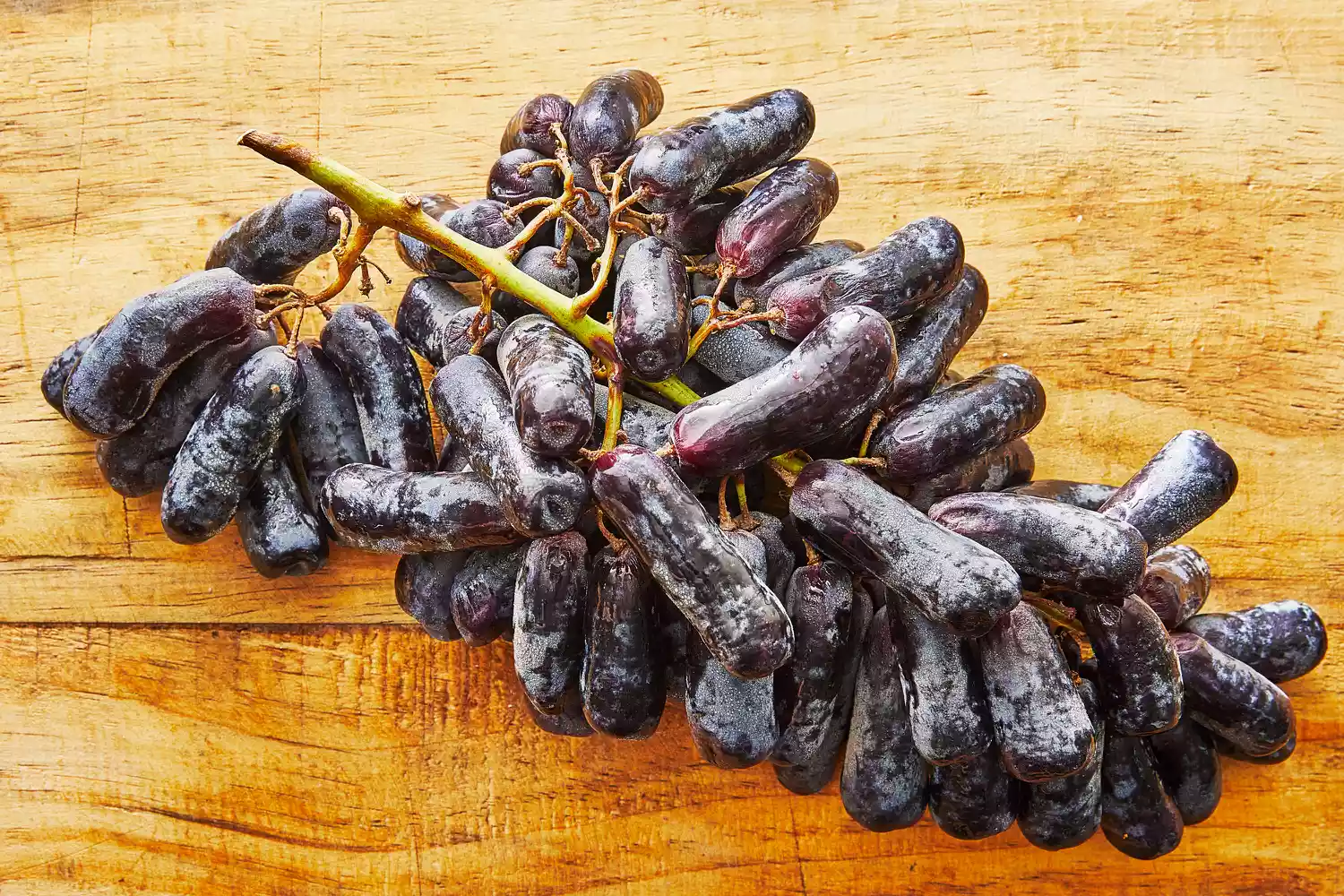Description/Taste
Sweet Sapphire™ grapes grow in large, loose clusters averaging 16 centimeters in diameter and 29 centimeters in length. It is estimated that each average bunch has around 154 berries, and each berry weighs around 10 grams with an elongated, tubular, and narrow shape. The uniform berries are 1.4 to 1.8 centimeters in diameter and 4 to 5 centimeters in length and showcase a characteristic dimple on one end. The grape’s skin is smooth, semi-thick, glossy, and taut. The skin is also dark purple, often appearing black, and is covered in a medium to heavy blue-grey bloom, also referred to as a cuticular wax. This bloom is natural and edible but can be easily wiped from the surface by hand, depending on preference. Underneath the skin, the translucent purple-green flesh is crisp, seedless, and aqueous with a crunchy, firm, and snap-like quality. The grape can be broken in half with fingers due to its firm consistency and elongated nature. Sweet Sapphire™ grapes are sweeter than standard black grape varieties, containing a high sugar content of 18 to 20 degrees Brix. This sugar content creates a refreshingly sweet, neutral taste with balanced acidity to enhance their classic grape juice flavoring.
Seasons/Availability
Sweet Sapphire™ grapes are available in the Northern Hemisphere in the late summer through early fall, with a peak season in late August through mid-September. In the Southern Hemisphere, the variety is in season from December through April.
Current Facts
Sweet Sapphire™ grapes, botanically classified as Vitis vinifera, are a specialty grape variety belonging to the Vitaceae family. The mid-season grapes are a black seedless variety that grows in large, loose bunches and are commercially sold as a table grape. Sweet Sapphire™ grapes were created using natural breeding techniques through International Fruit Genetics in California in the early 21st century and were selected for commercial release for their unique elongated shape, firm, snappy texture, and sweet taste. Since their release, Sweet Sapphire™ grapes have been cultivated through licensed growers worldwide and are a protected variety to ensure quality and consistency are maintained each season. Sweet Sapphire™ grapes are also known for their extended storage capabilities, making them a chosen cultivar for international export and shipping domestically. Consumers favor Sweet Sapphire™ grapes as a memorable fresh-eating table grape, but the variety is also versatile, utilized in a wide array of fresh or cooked, sweet or savory culinary preparations.
Nutritional Value
Sweet Sapphire™ grapes have not been studied for their nutritional properties. Like other black grape varieties, the grapes may be a source of potassium to balance fluid levels within the body, fiber to regulate the digestive tract, and vitamin C to strengthen the immune system. Black grapes also provide vitamin A to maintain healthy organ functioning, vitamin K to assist in faster wound healing, antioxidants to reduce inflammation and protect the cells against free radical damage, manganese to produce connective tissues, and contain other nutrients, including flavonoids, copper, and polyphenols.
Applications
Sweet Sapphire™ grapes have a sweet, neutral flavor suited for fresh and cooked preparations. The grapes are typically consumed straight out of hand and are a popular table grape for their unusual shape. The variety has a firm nature, allowing it to be sometimes snapped in half by hand, and the fruits are often served on cheese boards as a sweet accompaniment. Sweet Sapphire™ grapes are also served as an edible topping over grain bowls and breakfast dishes such as oatmeal, yogurt, cereal, and pancakes. The grape’s elongated nature can be halved, slightly hollowed, and stuffed with dips or cheeses, or it can be sliced and layered onto sandwiches for added sweetness and crunch. They can also be blended into smoothies and fruit juices.
https://specialtyproduce.com/produce/Sweet_Sapphire_Grapes_144825.php
